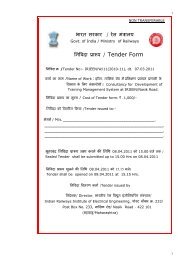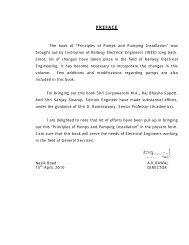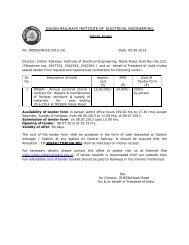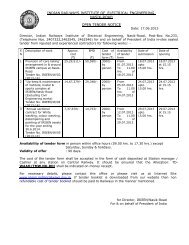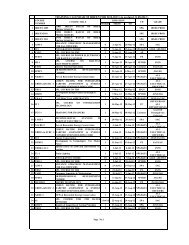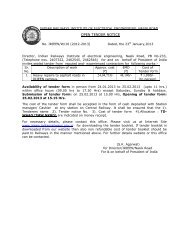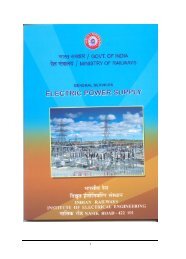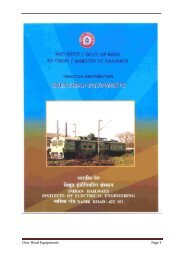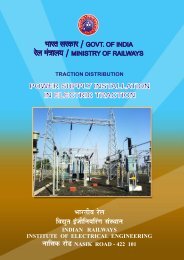Traction Rolling Stock - Indian Railways Institute of Electrical ...
Traction Rolling Stock - Indian Railways Institute of Electrical ...
Traction Rolling Stock - Indian Railways Institute of Electrical ...
Create successful ePaper yourself
Turn your PDF publications into a flip-book with our unique Google optimized e-Paper software.
which has the requisite inter connection between valves by means <strong>of</strong> cored passages in the<br />
casting itself, the only external pipe connections being from the main reservoir and brake pipes<br />
and atmosphere.<br />
7.3.5 Brake Controller<br />
The brake controller handle has five positions as under ;-<br />
(a) I ...... Release and Running<br />
(b) II ...... Full service EP<br />
(c) III ...... Lap (for auto application)<br />
(d) IV ...... Service automatic<br />
(e) V ...... Emergency<br />
The positions <strong>of</strong> brake controller is shown in fig. 7.3.5.<br />
Lower brake cylinder pressures with self-lapping feature as explained later are<br />
obtainable for intermediate positions <strong>of</strong> the handle between positions I and II, the actual brake<br />
cylinder pressure being dependent upon the degree <strong>of</strong> handle movement away from position I.<br />
7.3.6 E.P. brake system<br />
Fig 7.3.6 is a block diagram explaining the functioning <strong>of</strong> the EP brakes. When an EP<br />
application is to be made, the controller handle is moved from position I towards position II. (Fig<br />
7.3.5). First the holding train wire is energized which energizes the holding magnet valves<br />
throughout the train, thus closing the exhaust from the brake cylinders. The application valves are<br />
then energized via the application train wire. This causes compressed air to flow the brake<br />
cylinders from the main reservoir pipe, the rate <strong>of</strong> flow being controlled by a choke (not shown in<br />
the figure). If the application valve remains energized, the pressure in the brake cylinder builds up<br />
to 3.5 kg/cm², any rise <strong>of</strong> pressure beyond this value being prevented by the 'limiting valve'.<br />
Between positions I and II the self-lapping mechanism controls the brake cylinder<br />
pressure. Fig.7.3.5 shows the self-lapping mechanism schematically. Movement <strong>of</strong> the controller<br />
handle towards II compresses a spring in a small control cylinder, the amount <strong>of</strong> compression<br />
depending upon the degree <strong>of</strong> handle movement. This spring acts on piston at the back <strong>of</strong> which<br />
air pressure from the brake cylinders <strong>of</strong> the leading bogie is applied. When the brake cylinder<br />
pressure exceeds the value corresponding to the controller handle position, the mechanism deenergises<br />
the application train wire, thus limiting the brake cylinder pressure to value<br />
corresponding to the handle position. If the brake cylinder pressure drops on account <strong>of</strong> leakage<br />
etc. The application wire is re-energized. If the handle is moved backwards, the holding wire is deenergized<br />
till the brake cylinder pressure drops to the required value. The self-lapping mechanism<br />
thus automatically controls the brake cylinder pressure at definite value corresponding to the<br />
handle position and enables graduated application and release. In position II & V the application<br />
and holding circuits are energized by 'positive acting' contacts bypassing the self-lapping<br />
mechanism, the pressure then being limited by the limiting valve as explained earlier.<br />
Two indication lamps are provided on the Driver's desk a green lamp to indicate that EP<br />
brake control supply is available and an orange lamp which lights up when brake application is<br />
made if pressure has built up in all the bogies, which is detected by a pressure switch, the<br />
pressure switches in all the coaches being connected in series. The extinguishing <strong>of</strong> the green<br />
lamp indicates total failures <strong>of</strong> EP brakes necessitating use <strong>of</strong> the automatic brakes to control the




